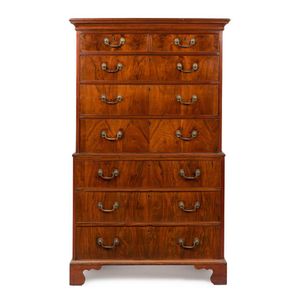George I Walnut Chest on Chest
A George I English chest on chest, walnut and pine with cockbeaded trim, concave moulded base rail, attractive cast brass drop handles (hand made but of a later period) and original brass escutcheons, circa 1725, 170 cm high, 98 cm wide, 51 cm deep
You must be a subscriber, and be logged in to view price and dealer details.
Subscribe Now to view actual auction price for this item
When you subscribe, you have the option of setting the currency in which to display prices to $Au, $US, $NZ or Stg.
This item has been sold, and the description, image and price are for reference purposes only.
- Circa - A Latin term meaning 'about', often used in the antique trade to give an approximate date for the piece, usually considered to be five years on either side of the circa year. Thus, circa 1900 means the piece was made about 1900, probably between 1895 and 1905. The expression is sometimes abbreviated to c.1900.
- Rail - A term used by cabinet makers for the horizontal sections of the frame of an item such as a chair or settee which have a front rail, a back rail and two side rails, and also on a door or carcase, where the rails are joined to the vertical framings.
- Drop Handles - In furniture of the late 17th and early 18th centuries, small metal drop handles were often used, frequently in a pear or tear shape. The back plate, to which the drop was attached, may be either a simple plain circle, or in the form of a star or diamond. These handles have been widely reproduced, and are frequently found on Jacobean and Queen Anne style furniture made after the first world war. Reproduction handles can usually be identified by the inferior quality of the metal used during the 1920s and 1930s, sometimes thinly coated with brass or copper, though modern copies are often of excellent quality.
- Escutcheons - An escutcheon is a plate, made of brass, wood, ivory or ebony, which fits into or over the h keyhole, to protect the edge of the timber keyhole from damage by continual insertions of the key. As a general rule you would expect these escutcheons to be sympathetic in design to the handles of the piece. From the early 19th century escutcheons were sometimes made from ivory, ebony, bone or contrasting wood, often cut in a diamond or shield shape and inlaid into the front. Ivory, in particular, will tend to discolour with age, and certainly should not show up as brilliantly white.
This item has been included into following indexes:
- chests of drawers, material
- chests of drawers, period - Georgian 777
- chests of drawers, style - chest on chest 144
